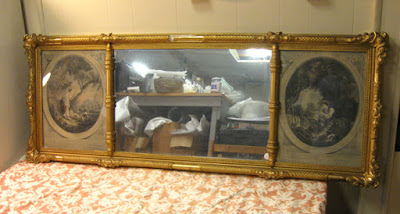Sometimes a project reveals information that, while not important or valuable, does at least liven up the day a bit.
When you need to work on an old frame or mirror, it is nice when you need to do a small repair without opening everything up. For bigger projects, you need to dismantle. This is primarily for ease of work (and minimizing risk too art or mirror plate. Sometimes you want to learn more, and need to look for clues inside.
This over-mantel mirror is in sorry condition. Probably English, 18th century, as soon as I saw it I knew the mirror was replaced (if the mirror was period). Mirrors of this type would not have a single panel of mirror plate; the custom was for three panels, usually with slightly beveled edges, and no wooden dividers between them. This is usually attributed to taxation on large panes of glass or mirror; probably just as likely to the logistics and expense of getting a single large piece.
 |
| Arrival in my elegantly appointed workshop |
In any event, as soon as I lifted it I knew the glass was
replaced, as this was heavy plate glass. While this type of glass is of good quality, it is not a good replacement for
antique mirrors that were made for thinner, lighter glass. Often times the
frames cannot support the weight, and hanging hardware pulls out of the old,
dry wood and the mirror comes crashing down. This one had eye-hooks and wire
spanning the frame; NOT the way you want to hang a mirror like this. A miracle
it survived at all.
First step was to remove the back panels.
 |
| Museum accession label |
Pasted on the backboard is a Cincinnati Art Museum accession
label from 1945, showing source as the Marquise de Talleyrand.
The nails holding the panels were modern wire nails, as would be expected with replaced mirror plate. And, as was common with framers years back, cardboard was used between the mirror and dust panels.
 |
| Cardboard a sign that this mirror has been worked on since the 18th century |
When I turned them over - a theatrical surprise! Someone had
used theater posters. The Ruth Gordon poster was for a play from the 1944
season; the ballet was likely from 1950. So unless the workshop had a really
old stash of stuff, this mirror plate was probably replaced in the early 1950s.
 |
| Maybe the workshop was in the theater district? |
Will need to stabilize the gesso, and make any infills
needed. The rails are not carved, then gessoed, but instead the gesso is built
into a thick layer and then carved. Tedious work to be sure.
This is another one of my personal projects, so it will
probably be pretty low on the priority list. Don't expect to see an update on
the finished project any time soon, but at least now, without the glass it's a
lot easier to lift into its storage slot.























